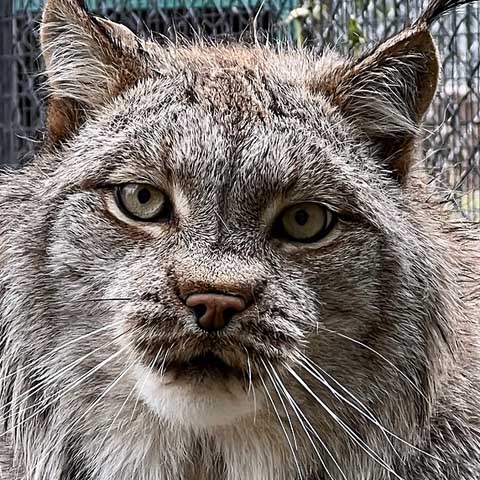Canada Lynx – Jynx & Sibella
(Lynx canadensis)
With their tufted ears, oversized paws, and mysterious gaze, Canada lynx are perfectly adapted to life in deep northern snow. At Cat Tales Wildlife Center, our two resident lynx—Jynx and Sibella—each have unique stories that help visitors understand the beauty and challenges of this northern predator. Together, they serve as ambassadors for responsible wildlife care and education about the risks of exotic animal ownership.
Meet Our Canada Lynx

Jynx – The Lynx with a Legacy
Born in 2007, Jynx-the-Lynx came to Cat Tales in August 2020 following the passing of his lifelong owner and bonded caretaker, Jon. His placement was arranged by a family friend who sought to honor Jon’s love for him by finding a sanctuary where Jynx could live safely and well cared for.
Exceptionally large and confident for his species, Jynx quickly made his presence known. Despite his history in private ownership, he arrived in good health—a rare outcome in rescues from the exotic pet sector. Now settled in his spacious habitat, Jynx enjoys observing his surroundings, grooming under shady trees, and engaging in playful interactions through the fence with neighboring lynx, Sibella.
Jynx’s story serves as a living reminder of the deep bonds that can form between humans and wild animals—and the importance of ensuring those bonds are met with responsible care and proper facilities.

Sibella – The Curious Companion
Born on May 10, 2018, Sibella arrived at Cat Tales as a four-month-old kitten in September 2018. Raised in our nursery by dedicated keepers, she quickly adapted to daily health checks and human presence while maintaining her natural lynx instincts.
As she matured, Sibella moved into the Small Cat Forest, where she now lives beside Jynx. She is playful, vocal, and curious—often seen “chattering” or batting at objects throughout her exhibit to catch her keepers’ attention. Her interactions with Jynx are a favorite among visitors, as the two often mirror each other’s movements, showcasing the species’ social awareness even outside breeding season.
Sibella continues to thrive as a beloved ambassador, demonstrating how proper husbandry and enrichment can support both physical and mental well-being for wildlife in human care.
All About Canada Lynx
- Built for Snow: Their snowshoe-like paws and long, powerful legs let them travel easily across deep snow in search of prey.
- Distinctive Appearance: A thick, silvery-gray coat, tufted ears, short black-tipped tail, and flared facial ruff give them a regal look.
- Specialized Hunters: Their diet centers on the snowshoe hare, whose population cycles every 8–10 years directly influence lynx numbers.
- Habitat: They thrive in the boreal and montane forests of North America, preferring older woodlands with dense undergrowth for cover.
- Stealth and Silence: Nocturnal and secretive, lynx hunt by ambushing prey near well-used trails, relying on patience and stealth more than speed.
The Canada Lynx and Private Ownership
Known for their solitary nature and strong territorial instincts, Canada lynx are not domesticated animals. In the exotic pet trade, they are often marketed alongside bobcats as “manageable wild cats,” but this label is dangerously misleading.
- Unpredictable Behavior: Even hand-raised lynx remain wild at heart. As they mature, they become increasingly protective of their “territory” or favored person, sometimes leading to serious aggression.
- Long-Term Commitment: In captivity, lynx can live up to 20 years, requiring specialized enclosures, diets, and veterinary care—far beyond what most owners can provide.
- Legal and Ethical Concerns: Ownership laws vary by state, but Canada lynx are generally classified as inherently dangerous wild animals. Their sharp teeth and hooked claws can inflict severe injury in seconds.
By providing safe, permanent homes for animals like Jynx and Sibella, Cat Tales gives them a second chance while educating visitors about why these magnificent cats belong in the wild.
Conservation & Ecology
Canada lynx populations remain stable overall, and the species is listed as Least Concern, though local populations in the lower 48 states are far more vulnerable. The greatest threats include habitat fragmentation, climate change, and declining snowshoe hare populations.
Deep, persistent snow is critical to their survival—it limits competition from other predators like coyotes and bobcats. As snow conditions become less predictable, lynx are forced to adapt to changing landscapes and prey patterns.
Through education and advocacy, Cat Tales helps visitors understand these ecological connections and how protecting native species begins with protecting their habitats.
Life at Cat Tales
Our Canada lynx enjoy custom-designed enclosures with platforms, dens, and vegetation that mimic their natural habitats.
- Enrichment: Daily activities encourage natural hunting and observation behaviors, such as hiding food in elevated spaces or introducing new scents.
- Seasonal Care: During winter, their thick coats and snowshoe paws shine as they adapt perfectly to the colder weather.
- Health Monitoring: Keepers track diet, weight, and behavior changes, especially during molting and seasonal transitions.
Visitors often spot Sibella bounding playfully through the snow or Jynx lounging in the shade—two contrasting personalities who embody both the spirit and serenity of their wild cousins.
How Jynx and Sibella Inspire
Education
Their stories shed light on the realities of exotic animal ownership and the specialized care required for wild species, helping visitors make informed choices about wildlife conservation.
Advocacy
Through public programs and interpretive signage, Jynx and Sibella help reinforce the message that wild cats are not pets, and that sanctuary care provides them a second chance for a quality life.
Research & Welfare
Observation of their behaviors contributes to ongoing studies in environmental enrichment, animal communication, and behavioral adaptation—improving care standards for lynx in managed care worldwide.


